As discussed in the introduction of this blog series, the maturation of the business architecture discipline makes the role of model-based support for design, analysis and decision-making increasingly important. Therefore, we introduced you to several useful techniques for business architecture modeling and how they are supported by Enterprise Studio. In this blog, we will discuss an approach to modeling a blueprint of one of the core domains of business architecture: Organization Mapping.
Business blueprints are abstract representations of reality that represent a wide variety of viewpoints. They enable organizations to visualize their business from a variety of perspectives, providing management with information about a given aspect of the business within a specific context. By doing so, blueprints deliver transparency that enables and streamlines business transformation and change across business units, capabilities, and stakeholders.
There are four core domains in Business Architecture: Capabilities, Value Streams, Organization and Information. For each core domain, the BIZBOK Guide® suggests an approach to create appropriate business blueprints. In previous blogs, we have already discussed Capabilities and Value Streams. In this blog, we will elaborate on creating a business blueprint for the Organization domain: Organization Mapping.
In Organization Mapping, the BIZBOK Guide® uses ‘business unit’ as its core concept, with a broad meaning, stating: “The interpretation of what comprises a business unit is largely up to the mapping team, as long as it reflects an organizational concept.” This requires flexibility in the modeling concepts used to create organization maps. Luckily, the relevant concepts of the ArchiMate language provide this flexibility (see below).
Moreover, an organization map goes well beyond the traditional hierarchy chart by depicting internal and external relationships and collaborations from a business unit or business entity perspective. An organization map is a business blueprint that depicts business units, organizational decomposition, and other types of organization-oriented relationships. The difference with traditional hierarchical models of a business is that hierarchical models do not facilitate an accurate depiction of horizontal relationships and traditionally focus on reporting structures versus organizational alignment.
The ‘basic organization map’ proposed in the BIZBOK Guide® is built from the examination and documentation of business units and business unit decomposition across the enterprise. It consists of two basic concepts: enterprise and business unit. There is one relationship: ‘Decomposes Into’.
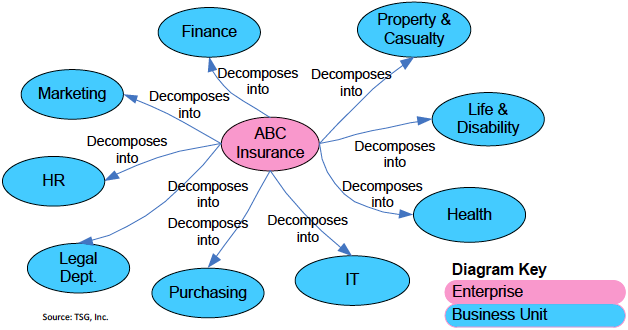
Source: BIZBOK Guide® 5.5 p.116, Figure 2.3.5: Basic Organization Map
We prefer using ArchiMate’s formal semantics for modeling direct relationships between each instance of a business architecture domain. Translating BIZBOK’s ‘basic organization map’ to ArchiMate, we propose:
By doing so, the ‘basic organization map’ could look as follows, with ‘ABC Insurance’ being the Enterprise:
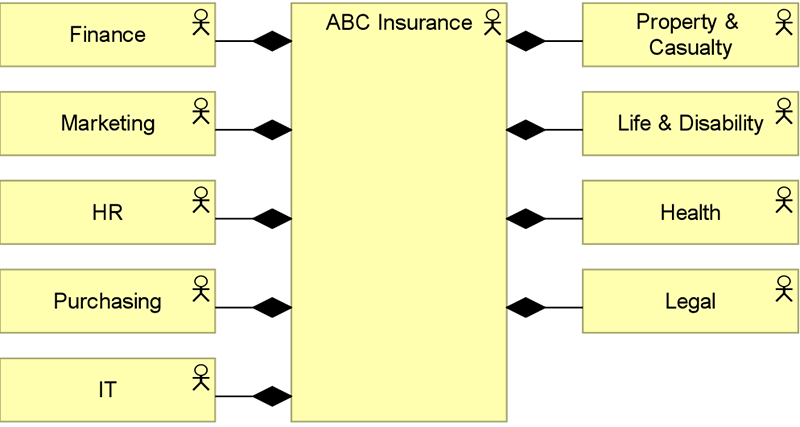
‘ABC Insurance’ basic organization map
The following model is an example of a different representation of an organization structure, with less focus on hierarchy, but still only depicting an enterprise (Archisurance) and its business units:
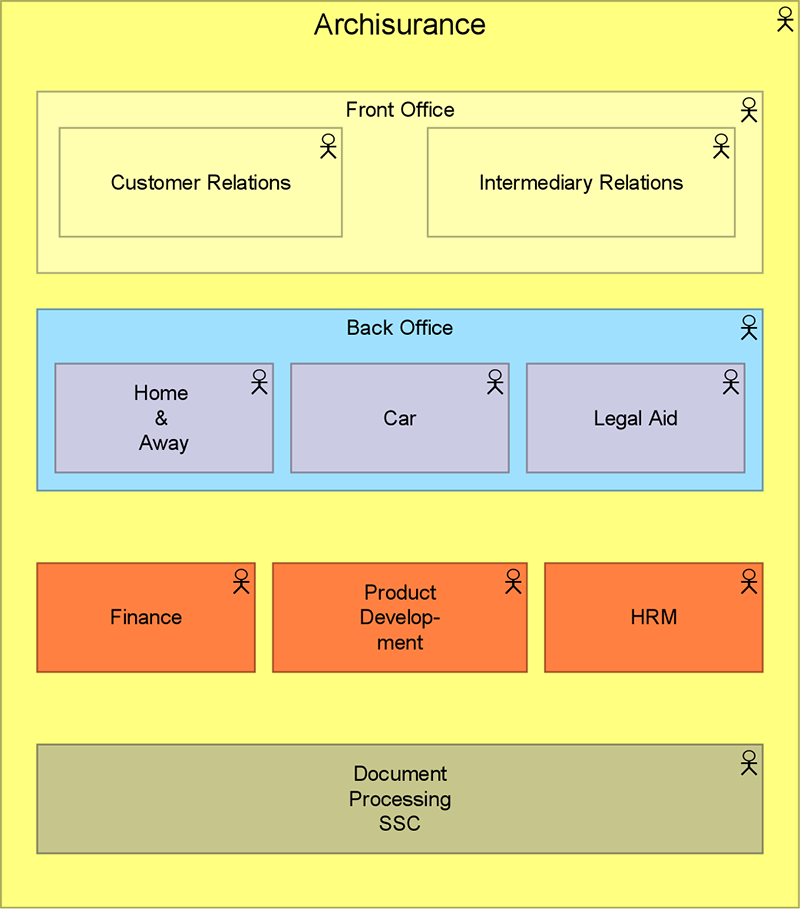
Archisurance organization structure
The basic organization maps as depicted above are easy to build and understand, but they are not the only thing you may want to model in organization mapping.
Organization structures comprise more than hierarchy alone. You may also want to model the responsibilities of business units, departments and other organizational actors, sometimes down to the level of, for example, management responsibilities of individuals. The BIZBOK® does not address this aspect of organization mapping, but in practice, knowledge about management responsibilities is essential in any business architecture endeavor. The appropriate concept for this in ArchiMate is ‘Business Role’, defined as “the responsibility for performing specific behavior, to which an actor can be assigned, or the part an actor plays in a particular action or event.”
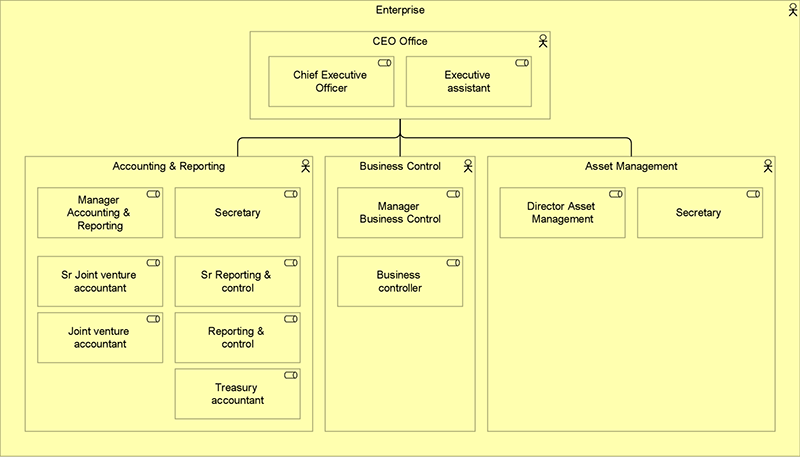
Enterprise governance structure model
Using this concept enables us to model the governance structure of the enterprise, which is of course essential in any transformation or change initiative. Change should be enacted and guided by the responsible managers, and your change management approach critically depends on this governance structure. Moreover, this governance structure itself may be subject to change. And there are many more reasons for modeling these responsibilities. Take, for example, regulatory compliance, which may impose strict rules on accountability, governance and reporting structures.
You can also fruitfully use these concepts of Business Actor and Business Role in combination with other ArchiMate concepts to create cross-mappings with other parts of your business architecture model. For example, you can map business actors or roles to business functions or processes, creating matrices that depict who is responsible for which activities of the enterprise. See for instance the following Actor – Function cross mapping:
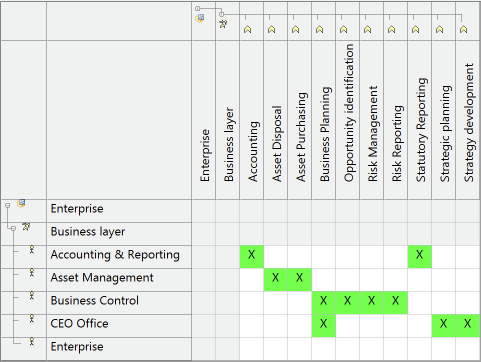
Function cross mapping
Other relevant cross-mappings that you can model using ArchiMate include:
As you can see, organization maps are an important foundation for many aspects of your business architecture. The ArchiMate concepts and their implementation in Enterprise Studio are a great tool to support these. In our next blog, we will elaborate on the fourth leg of business architecture: information mapping.